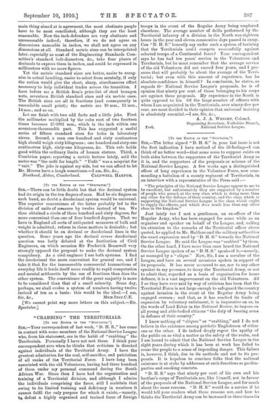[To TES EDITOR oP TIER " SPECTATOR. "] Sra,—Half-crown and florin.—Mr.
Moores (August-20th) seems to think it his duty as an anti-metricalist to defend the half- crown against the florin. Why P The florin is nothing metric ; it is two dozen pence. The half-crown is ten threepenny-bits, and could easily be the unit of a decimal coinage.
Twelve or ten?—Have Mr. F. M. Hunt and Mr.Lewis Edmunds (August 20th) never considered eight P If ever we abandon ten, I hope it will be for eight, not twelve. No Anglo-Saxon ever instinctively divides things into twelfths. Even the word " dozen " is French. Divisibility by three is of little use. I have met fairly intelligent people who could not understand what a third was, except by being told it was a little more than a quarter. Even where articles are counted in dozens, as in drapery warehouses, four articles do not appear on. the stock list as one-third dozen, but as four. twelfths.
Microscopic sizes.—Mr. J. W. Gordon (August 27th) thinks " one ten-thousandth of an inch " easier than " 2e." I do not. Two syllables are easier than seven. Secondly, Mr. Gordon's figures do not agree. A fifth of a metric unit is not a hundred-thousandth of an inch, but a hundred-and-twenty- seven-thousandth. Thirdly, if the inch is natural because the eye's focal length is ten inches, then the millimetre is natural because the smallest visible length is one-tenth of a milli. metre, and the smallest easy print one millimetre.
Mental exercise.—Mr. Rees (September 3rd) thinks our measures are good because they are numerous and difficult. How he must regret the disappearance of the ruck, the hutch, the hyle, the Scottish inch (10054 English inch), the bing (still heard of in Durham lead mines), the twelve-and- half-pound stone, the Cheshire acre (nearly equal to the hectare), and some hundreds of other curiosities !
Engineering Standards Committee.—Mr. Ilooreli (Sep. tember 3rd) says the Engineering Standards Committee is naming standard diniensions in inches. So should I, very likely. I should argue thus : It is well known that when the
main thing aimed at is agreement, the most obstinate people have to be most conciliated, although they are the least reasonable. Now the inch-defenders are very obstinate and unreasonable indeed; therefore, if we do not agree on dimensions nameable in inches, we shall not agree on any dimensions at all. Standard metric sizes can be interpolated later, especially as most of the Engineering Standards Com- mittee's standard bolt-diameters, &c., take four places of decimals to express them in inches, and could be expressed in millimetres with no more figures.
Yet the metric standard sizes are better, easier to recog- nise in actual handling, easier to select from mentally, if only the nation would give the short, sharp, simultaneous effort necessary to help individual trades across the transition. I have before me a British firm's price-list of steel hexagon nuts, seventeen British standard sizes and six metric ones. The British sizes are all in fractions (and consequently in unreadable small print); the metric are 10 mm., 12 mm., 14mm., and so on.
Let me finish with two odd facts and a little joke. First the millimetre multiplied by the cube root of two fourteen times becomes 25'3982 mm., which is the inch within one seventeen-thousandth part. This has suggested a useful series of fifteen standard sizes for holes in laboratory sieves. Second, a man one hundred and sixty centimetres high should weigh sixty kilograms ; one hundred and sixty-one centimetres high, sixty-one kilograms, &c. This rule holds good within the ordinary limits of human stature. Third, a Cumbrian paper, reporting a metric lecture lately, said the metre was " the unfit for length." " Unfit " was a misprint for "unit." The joke is against my side, but we can afford to let Mr. Moores have a laugh sometimes.—I am, Sir, &c.,
Nentheed, Alston, Cumberland. CALDWELL HARPUB.







































 Previous page
Previous page